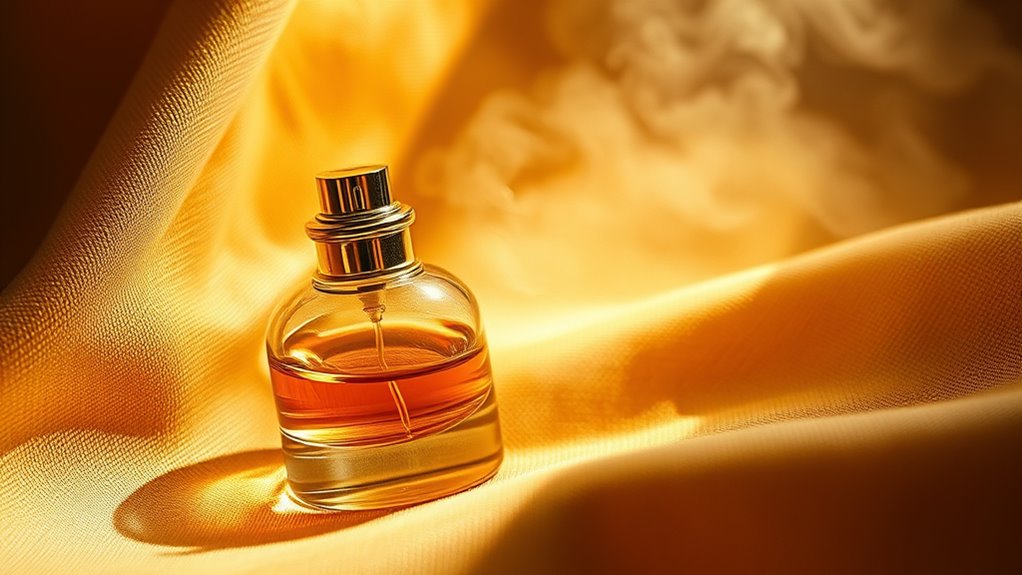Fragrance notes change over time because of chemical reactions, evaporation, and environmental factors. When you apply a scent, the top notes hit first, fading quickly, while heart notes emerge and then fade. Base notes linger the longest, developing gradually. Temperature, humidity, and air quality affect how notes evolve and fade. Understanding these shifts helps you appreciate a fragrance’s complexity and personality—keep exploring to discover how these processes shape your scent experience.
Key Takeaways
- Fragrance notes evolve through chemical reactions like oxidation and hydrolysis, altering scent profiles over time.
- Top, heart, and base notes evaporate at different rates, shaping the fragrance’s development and perception.
- External factors such as temperature, humidity, and air quality influence how notes emerge and fade.
- Understanding note progression helps in appreciating a fragrance’s complexity and longevity.
- Tracking scent changes enhances personal connection and informed selection based on how fragrances develop on the skin.
The Structure of Fragrance Notes: Top, Heart, and Base

Fragrance notes are structured into three main layers: top, heart, and base, each playing a distinct role in the scent’s development. The top notes are what you smell immediately upon application; they set the initial impression and are often light and volatile. As these fade, the heart notes emerge, forming the core character of the fragrance and lasting longer than the top notes. They reveal the true personality of the scent. Additionally, the choice of materials used in creating various fragrance notes can influence how they change and persist over time. Recognizing how composition impacts scent development can deepen your appreciation for the artistry behind perfume creation. The features of each note, such as their volatility and molecular weight, determine how quickly they evaporate or linger, shaping the overall fragrance experience. Understanding the oxidation process can also help explain why a fragrance’s scent evolves over time, adding depth to the aromatic journey.
The Chemical Processes Behind Scent Transformation
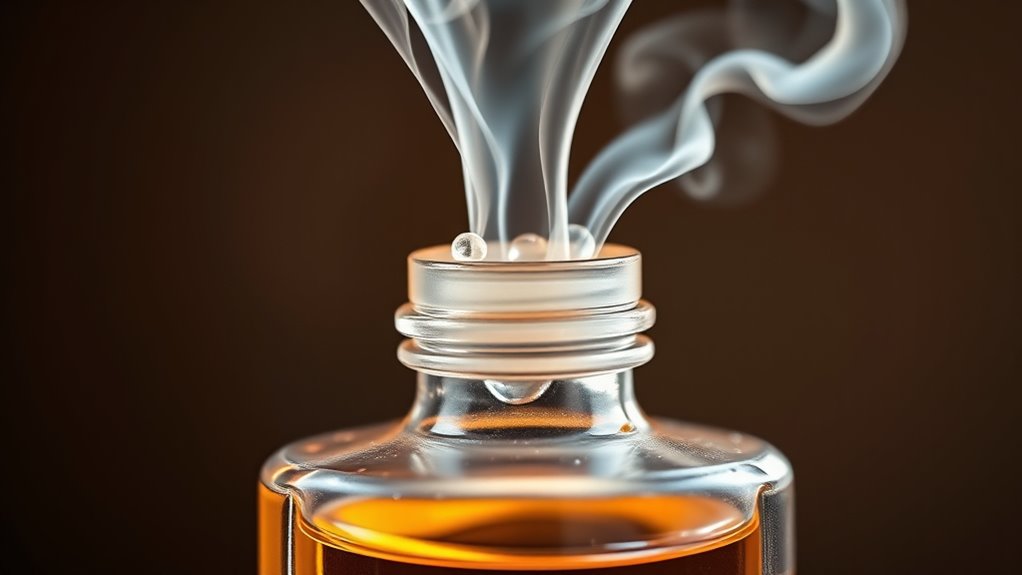
As a perfume unfolds over time, chemical reactions and evaporation drive the transformation of scent notes. When you wear fragrance, molecules from the perfume interact with your skin’s natural oils, triggering complex chemical processes. Oxidation, for example, occurs when oxygen reacts with aromatic compounds, altering their scent profiles and creating new, often deeper, notes. Hydrolysis breaks down larger molecules into smaller ones, changing the fragrance’s character. Additionally, some ingredients undergo rearrangements, forming entirely different compounds that influence the scent’s evolution. These chemical transformations happen gradually, shaping how each note develops and fades. Understanding these processes helps explain why fragrances change over hours and why certain scents shift from fresh and vibrant to warm and earthy.
The Role of Evaporation and Volatility in Fragrance Evolution
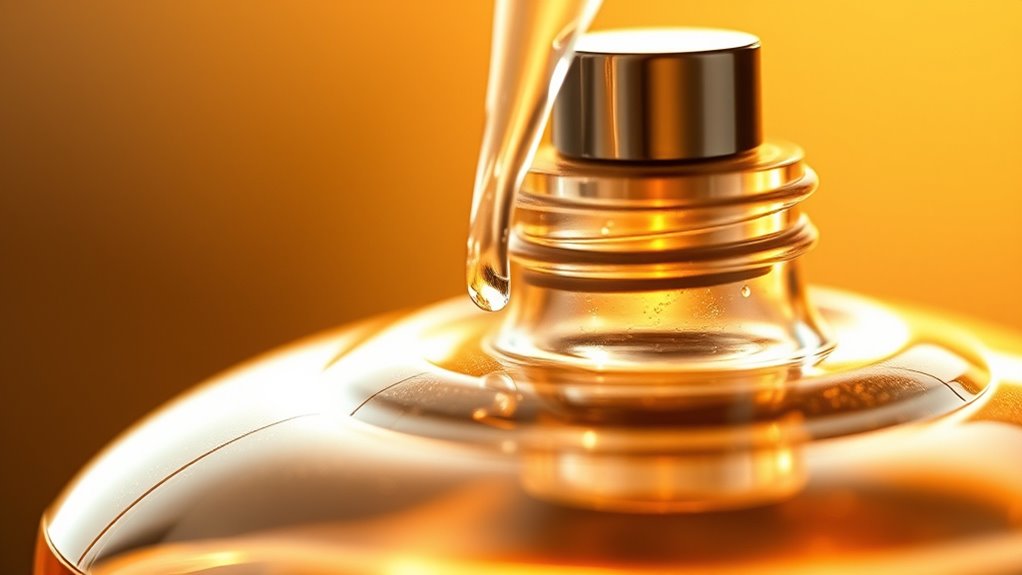
You’ll notice how different fragrance notes evaporate at varying speeds, shaping the scent’s development over time. Top notes evaporate quickly, giving way to heart and base notes that last longer, thanks to their lower volatility. Understanding how evaporation rates influence longevity helps you appreciate the complex evolution of your favorite scents. Additionally, color stability and intensity are affected by the volatility of specific notes, further contributing to a fragrance’s overall character over its lifespan. The cultural impact of fragrance trends also plays a role in how formulas are crafted to appeal to evolving preferences. Incorporating filter technology principles from air purifiers highlights how controlling volatile elements can influence scent longevity and stability.
Evaporation Rates Differ
Because different perfume ingredients have varying levels of volatility, their evaporation rates don’t all match up, shaping how a fragrance evolves over time. Some ingredients, like citrus or aldehydes, evaporate quickly, making their presence prominent early on. Others, such as woody or amber notes, evaporate more slowly, lingering longer and revealing themselves gradually. This difference means your scent changes as it wears, shifting from fresh and sharp at first to deeper, richer tones later. You might notice the initial burst of brightness fading, while the base notes become more apparent. Additionally, understanding the Worth of different ingredients can help in designing fragrances that evolve beautifully on the skin. Recognizing the evaporation process can also aid in selecting ingredients that complement each other over time. By analyzing the processing power of ingredients, perfumers can craft scents that unfold complex layers during wear. The volatility of ingredients directly influences how quickly a scent evolves, impacting the overall fragrance experience. Understanding these evaporation differences helps you appreciate why fragrances develop uniquely on your skin, giving each scent a dynamic life that transforms over hours. Furthermore, proper storage of perfumes can help maintain the intended evaporation rates and fragrance integrity over time.
Top, Heart, Base Notes
Top, heart, and base notes each play a distinct role in a fragrance’s evolution, driven by their volatility and evaporation rates. You’ll notice the top notes hit first—they’re the lightest, evaporating quickly to create your initial impression. As these fade, the heart notes emerge, offering the core character of the scent; they last longer but still evaporate relatively fast. Additionally, the composition of a fragrance influences how each note interacts and changes over time, affecting the overall scent development. Finally, the base notes anchor the fragrance, lingering the longest and providing depth and richness. This progression is influenced by each note’s volatility: highly volatile notes evaporate rapidly, while less volatile ones slowly release over time. Understanding this hierarchy helps you appreciate how a fragrance transforms on your skin, revealing different layers and complexities as it evolves.
Volatility Influences Longevity
The rate at which fragrance notes evaporate directly impacts how long each layer of a scent lasts on your skin. More volatile notes fade quickly, forming the top layer, while less volatile ones linger longer as heart and base notes. This evaporation process shapes the fragrance’s evolution over time. Additionally, essential oil volatility influences how quickly a scent changes and how long it remains noticeable on the skin. Understanding fragrance composition can help you select scents that match your desired longevity, ensuring your fragrance stays compelling throughout the day. The evaporation process is also affected by environmental factors such as temperature and humidity, which can alter how a fragrance develops. Additionally, patch testing can help determine how your skin reacts to different fragrance notes.
How Environmental Factors Influence Note Development

Environmental factors such as temperature, humidity, and air quality can considerably shape how fragrance notes develop over time. When it’s hot, your perfume may release top notes faster, causing a brief burst before settling into the heart and base notes. High humidity can amplify or soften certain scents, making floral or woody notes more prominent or muted. Poor air quality, like pollution or cigarette smoke, can alter how fragrance molecules interact with your skin and environment, potentially distorting the scent’s evolution. Additionally, exposure to sunlight can cause some notes to break down or change, affecting longevity and overall perception. Moreover, AI vulnerabilities highlight the importance of understanding how external influences can unpredictably impact complex systems like fragrance development. External environmental conditions can also influence the note longevity, impacting how long a scent remains perceptible on the skin or in the air. Recognizing how environmental variables interact with fragrance components helps in selecting scents suited for different settings and conditions. Changes in air circulation can also affect how scents disperse and linger, altering the overall fragrance experience. Understanding the factors affecting scent can help consumers make informed choices about when and where to wear certain fragrances, ensuring optimal enjoyment. By understanding these factors, you can better predict how a fragrance will behave on your skin and in different settings.
The Impact of Fragrance Composition on Its Aging Process
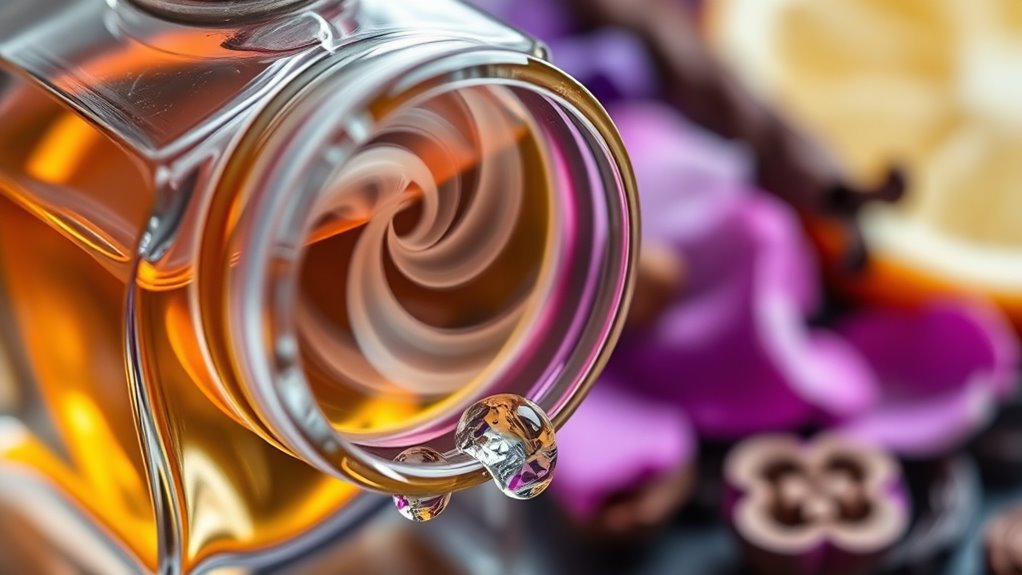
Fragrance composition plays a crucial role in how a scent ages over time. The specific blend of top, middle, and base notes determines how the fragrance evolves. For instance, a perfume rich in citrus or fresh notes may fade quickly, while those with woody or amber base notes tend to develop more complexity and longevity. The quality and concentration of ingredients also influence aging; natural oils often mature differently than synthetic compounds. Additionally, the balance between volatile and stable components affects how quickly certain notes fade or emerge. When you understand the composition, you can predict how a fragrance will change, helping you select scents that age gracefully or evolve in ways you prefer. Moreover, research supports that core personality traits impact how individuals perceive and enjoy different scent developments over time. Understanding fragrance longevity factors allows for better anticipation of how a scent develops. Ingredient quality also plays a significant role in the aging process, with higher-quality ingredients generally resulting in a more refined and enduring scent. Ultimately, the ingredients set the foundation for a scent’s unique aging journey.
Practical Tips for Appreciating Fragrance Changes Over Time
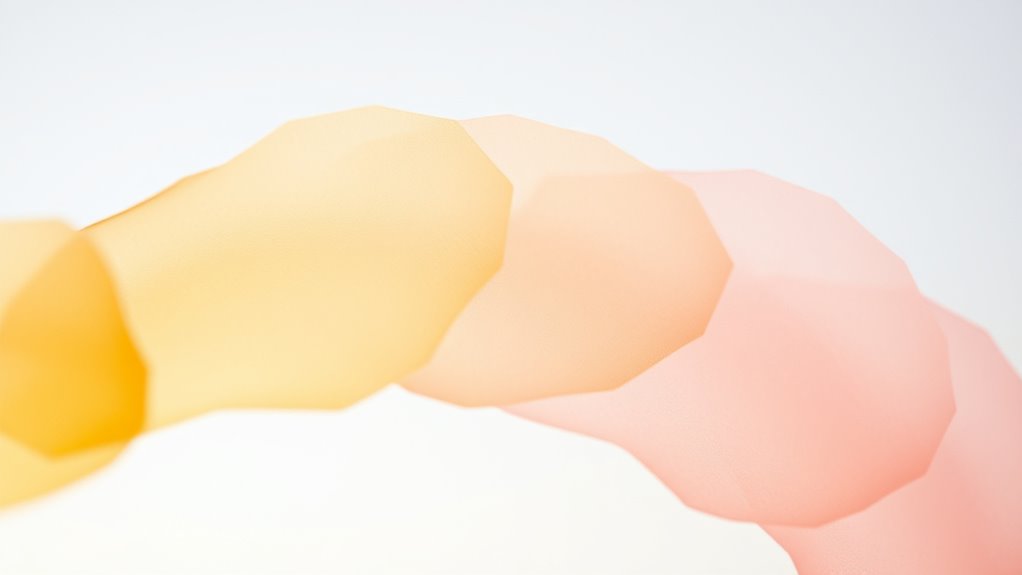
To truly appreciate how a fragrance evolves, you should smell it at different stages and note the changes. Using proper testing methods, like applying it on clean skin and allowing it to settle, helps you catch subtle shifts. Keep track of these observations to better understand each scent’s unique transformation over time.
Smell in Different Phases
As you begin experiencing a fragrance, you’ll notice it unfolds in distinct phases, each offering a unique scent profile. The initial burst, or top notes, hits your senses immediately—fresh, light, and volatile. These fade quickly, giving way to the heart notes, which reveal the perfume’s core character—rich, floral, spicy, or fruity. As the heart settles, the base notes emerge, providing depth and lasting power—warm, woody, musky, or amber. To truly appreciate these changes, give yourself time between applications, and pay attention to how the scent evolves on your skin. Smell slowly and note each phase’s distinct aroma. This mindful approach helps you understand a fragrance’s complexity and how it interacts with your body chemistry over time.
Use Proper Testing Methods
When testing a fragrance, applying it properly helps you notice how its scent transforms over time. Start with a small amount on clean, dry skin, preferably on pulse points like wrists or neck, where warmth enhances the scent. Hold the bottle about six inches away and mist lightly to avoid overwhelming your senses. Wait a few minutes after application before sniffing; this allows the top notes to fade and reveals the heart and base notes. Avoid rubbing the fragrance into your skin, as it can alter the scent. Keep track of how the aroma evolves during the day by noting changes in scent intensity, character, and longevity. Using consistent testing methods ensures you accurately observe the fragrance’s development over time.
Track Fragrance Evolution
Tracking how a fragrance evolves throughout the day allows you to truly appreciate its complexity. To do this effectively, wear the scent for several hours, noting how each note emerges and fades. Keep a small journal or mental notes about the changes you observe—when certain notes peak or disappear. Pay attention to the scent’s overall mood and how it shifts from fresh to warm or sweet. Reapply at different times to see if the fragrance’s character changes with your environment or skin chemistry. This practice helps you understand the fragrance’s structure and personality. Over time, you’ll develop a more nuanced appreciation for how notes interact and transform, deepening your connection to the scent and enhancing your overall fragrance experience.
Frequently Asked Questions
How Do Fragrance Notes Differ Between Natural and Synthetic Ingredients?
You’ll notice that natural ingredients often have more complex, evolving notes, providing a richer, more authentic scent. Synthetic ingredients tend to be more consistent and stable, offering brighter or more precise notes. When choosing fragrances, consider how natural ingredients might change over time, creating a dynamic experience. Synthetic notes maintain their intended aroma longer, ensuring your scent stays true to the original design. Both have unique qualities that influence how a fragrance develops on your skin.
Can Aging Perfumes Develop New Scent Characteristics Over Time?
They say “time reveals all,” and aging perfumes truly do develop new scent characteristics. As you wear your perfume over months or years, the fragrance’s notes can evolve, revealing richer or deeper layers. This change occurs because the chemical composition alters, especially in natural ingredients. So, your once-familiar scent can become more complex, making it a unique, personal experience that deepens with time.
How Does Storage Temperature Affect Fragrance Note Evolution?
You need to know that temperature plays a key role in how your fragrance develops. When you store perfume at high temperatures, the chemical compounds can break down faster, causing the scent to change or fade more quickly. Cooler, consistent temperatures help preserve the original notes and slow down any unwanted changes. So, keep your perfume in a cool, dark place to maintain its intended scent and longevity.
Are Certain Fragrance Families More Prone to Note Changes?
Certain fragrance families are more prone to note changes because of their complex compositions. For example, citrus scents tend to fade faster, losing their bright top notes quickly, while woody and oriental fragrances hold their base notes longer, evolving more slowly over time. If you prefer stability, choose fragrances from these families. However, if you enjoy evolving scents, those with citrus or floral top notes might suit you better.
How Do Personal Skin Chemistry and Environmental Factors Alter Scent Development?
You might notice your scent evolving because your skin chemistry and environment play big roles. Your skin’s oils, pH, and even diet can amplify or mute certain notes, making fragrances smell unique on you. Environmental factors like temperature, humidity, and air quality also influence how a scent develops. So, trust your nose—what you wear today might smell differently tomorrow, and that’s part of the fun of finding your perfect fragrance.
Conclusion
As you explore how fragrance notes evolve, you’ll discover there’s more beneath each scent than meets the nose. The subtle shifts, influenced by chemistry and environment, hint at secrets waiting to be uncovered. Will your favorite fragrance reveal hidden layers over time? Pay close attention, and you might unseal a deeper understanding—one that transforms your entire perception of scent. The journey into fragrance’s mysterious transformation has only just begun.
